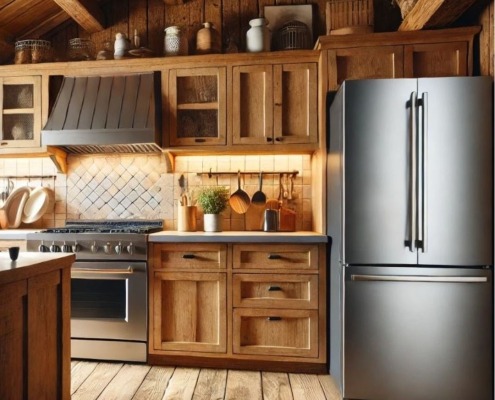How To Replace Whirlpool Refrigerator Air Duct WP2254354
Steven E / Wednesday June 4, 2025
Is your fridge no longer keeping your food cold and fresh? A blocked or damaged air duct might be the sneaky issue behind this inconvenience, but fear not—it’s a straightforward fix you can tackle yourself. Dive into our step-by-step guide below and watch the accompanying video to get your refrigerator running smoothly again!
Looking for the right part? Enter your appliance model number below to find the exact match and get your appliance running like new again!
If your Whirlpool, KitchenAid, or Maytag refrigerator isn’t cooling like it should, a damaged or blocked air duct (part #WP2254354) could be the culprit. This duct helps circulate cold air from the freezer to the fridge section—so if it’s not working right, your food might not stay as fresh. Replacing the air duct might sound tricky, but it’s actually a pretty simple fix you can handle at home. In this guide, we’ll show you how to replace the air duct step-by-step and get your fridge back to keeping things cool.
Watch the repair here: How to replace air duct
The information in this article may not apply to your specific appliance model. We recommend consulting your manufacturer’s documentation or contact us with any questions.
Tool and materials
Gather the following tools and new parts before starting:
- 1/4 in nut driver
- Pair of needle nose pliers
- Replacement air duct (Whirlpool part #WP2254354)- Take your model number to AppliancePartsPros.com to locate the correct part for your unit.
Safety precautions
When working on any appliance, remember to keep safety first. Here are some tips to keep in mind:
- Always power off and unplug your appliance or switch off the circuit breaker before attempting any maintenance or replacement work. This keeps you safe by preventing any risk of injury from electric shock.
- Wear insulated work gloves to protect your hands from sharp metal parts, pinching hazards and debris.
- Take your time and don’t rush while working to prevent accidents and personal injuries.
- Work in a well-lit area so you can clearly see and access the interior parts.
- Clear your workspace of clutter and other obstacles. Keep children and pets away from the work area.
- Never work on internal parts with bare wet hands. Make sure the work area is completely dry.
- Check your user manual to see if there are specific installation or safety instructions for your part or appliance.
- Be gentle when handling or removing parts. Excessive force might damage the appliance or cause injury.
- Wear safety glasses when working with chemicals, dust or cleaning large debris to prevent injury.
- If the appliance has recently been used, give it plenty of time for any heating parts to cool down before working on it.
- Take pictures or make a note of wiring terminals or other connections before disconnecting to prevent any problems with reassembly.
- When working with wires, avoid touching any exposed wires or terminals. If you need to touch a wire, use a non-conductive tool or wear insulating gloves to prevent electrical shock.
- Turn off the water supply at the outlet before beginning repairs to any appliance parts that hold water. Have towels ready for any residual water in the system when removing parts.
Step 1: Remove the ice bucket and ice maker
- Open the freezer door and slide out the ice bucket, setting it aside.
- Use a 1/4 in nut driver to remove the three screws securing the ice maker – two at the top and one at the bottom.
- Locate the power plug on the side of the ice maker. Pull up on the tab to disconnect the plug.
- With the screws and plug removed, you can now detach and remove the entire ice maker assembly. Place it aside with the ice bucket.
Step 2: Take out the shelf and evaporator cover panel
- To remove the shelf, lift up the right side and push it inward to release the left side from the wall. Then lift the left side all the way up to slide out the right side, and remove the shelf.
- Use the 1/4 in nut driver again to remove the two screws securing the evaporator cover panel. There is also a ground wire clip that must be detached from the panel using pliers.
- With all fasteners released, tilt the panel forward and slide it out. Be careful to feed any wiring through the openings as you remove it.
Step 3: Detach the old air duct
- Flip the panel over and locate the plastic retention clips for the air duct – two at the top and three across the bottom.
- Insert the needle nose pliers behind each clip and gently pry upward to release the air duct. Take care not to damage any surrounding plastic components.
- After you’ve disconnected all five clips, just slide them out through the top and bottom openings to take the air duct off the panel.
Step 4: Install the replacement air duct
- Orient the replacement WP2254354 air duct upright with the intake cutouts positioned correctly.
- Align the duct retention clips with their corresponding slots and evenly push downward. This will snap the new part securely into position.
- Inspect the reinstalled air duct and realign any bent or misshapen metal retention tabs using the needle nose pliers to avoid air leaks.
Step 5: Reassemble the refrigerator
- Carefully replace the evaporator cover panel, reattaching all screws and grounding wires. Make sure you have a tight seal all the way around.
- Reinstall the freezer shelf into both left and right side supports.
- Hang the ice maker assembly on the upper rear screw, reconnect the power plug, then replace the two remaining screws.
- Finally, slide the ice bucket back into position beneath the ice maker.
More Information
Thanks for reading! We hope this guide helped you successfully replace the air duct in your Whirlpool, KitchenAid or Maytag refrigerator.
If you still need some replacement parts, grab your model number and head over to AppliancePartsPros.com. We offer over two million parts and most orders arrive in two business days. If you need some help with finding the right part or placing an order, you can contact our team at 1 (877) 477-7278.
While you’re waiting for your new part to arrive, you can explore our DIY blog and watch thousands of video tutorials on our YouTube channel.
Be sure to follow us on Facebook, Twitter and Instagram to see our latest repair guides!
With nearly a decade of experience in providing top-notch customer service regarding appliance parts and repair, Steven enjoys sharing practical advice, troubleshooting tips, and interesting information to help readers stay informed.





